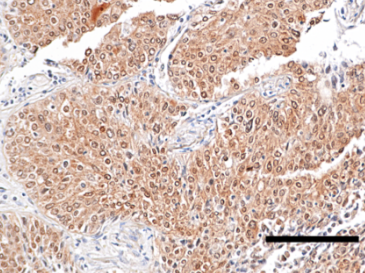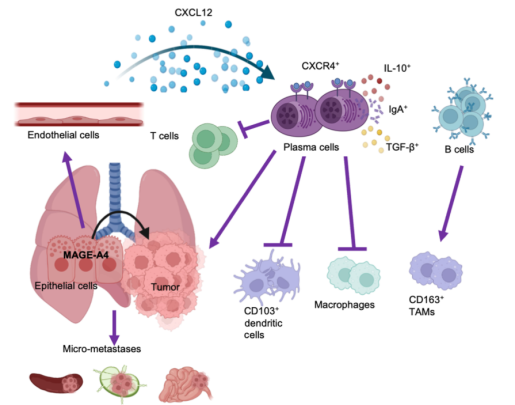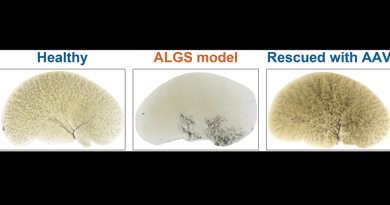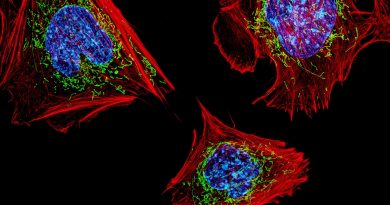How MAGE-A4 helps tumors evade immune responses crucial for their elimination

Researchers at Baylor College of Medicine and collaborating institutions have discovered in a mouse model of non-small cell lung cancer a novel strategy that allows tumors to evade the body’s immune responses developed for their elimination. Importantly, the study points at potential therapeutic avenues that could restore the ability to fight the tumor.

“It’s known that patients with lung cancers that express MAGE-A4 have an unfavorable prognosis, but whether or how this protein helps cancer grow was not well understood,” said corresponding author Dr. Farrah Kheradmand, Nancy Chang, Ph.D. Endowed Professorship for the Biology of Inflammation Center and professor of medicine-pulmonary at Baylor. “In the current study, published in Science Advances, we investigated the malignant potential and immunological roles of MAGE-A4 in mouse and human non-small cell lung cancer.”
MAGE-A4 does not work alone
The researchers developed a mouse model that expressed MAGE-A4 in the airway expecting that it would promote cancer growth. “To our surprise the cancer did not develop; it seemed that something was missing for this to happen,” said Kheradmand, member of the Dan L Duncan Comprehensive Cancer Center and core faculty at the Center for Translational Research on Inflammatory Diseases in the Michael E. DeBakey Veterans Affair Medical Center. “We approached co-author Dr. Chad Creighton, professor of medicine and co-director of Cancer Bioinformatics at the Dan L Duncan Comprehensive Cancer Center, who has expertise with the Cancer Genome Atlas, a large dataset of genetic changes associated with human cancers.”

Creighton researched the dataset and found that tumors in which MAGE-A4 was present also had lost PTEN, a tumor suppressor gene. To mimic this situation, the researchers developed a mouse model that expressed MAGE-A4 and lacked Pten. The tumors developed quickly in these mice and were also very aggressive, becoming metastatic in several months, which is faster than in other models of the disease.
“We were excited about this finding because it showed that MAGE-A4 was not only an indicator of severity and poor prognosis, but it also pushed cancer forward in combination with the loss of a tumor suppressor gene, Pten in this case, revealing a novel mechanism of tumor growth,” Kheradmand said.
MAGE-A4 triggers evasive maneuvers

Working with this new model of non-small cell lung cancer, first author Dominique Armstrong, a graduate student in the Kheradmand lab, led the work to uncover how MAGE-A4 promotes tumor growth. The team studied the tumors under the microscope searching for clues.

“We saw that the tumors were surrounded by immune cells that were not present in normal lungs,” Kheradmand said. “Co-author Dr. Linda Green, professor of pathology and immunology at Baylor and lung cancer expert at the Michael E. DeBakey VA, identified them as plasma cells, immune cells that specialize in producing antibodies.”
Further investigations into the immune mechanisms involved revealed that tumors had an abundance of plasma cells producing IgA antibodies as well as IL-10 and TGF-beta, two compounds that suppress the immune response. Lung endothelial cells in the tumor microenvironment produced more CXCL12, a compound that attracts plasma cells.

Eliminating all B cells restores antitumor immunity
In addition, immune T cells, typically in charge of fighting the tumor, were excluded from the tumor microenvironment, reducing the ability of the immune system to eliminate the tumor. Importantly, eliminating all B cells, which includes plasma cells, in the mouse model increased T cell infiltration in the lungs and significantly reduced tumor burden.

“We corroborated these findings in human samples,” Kheradmand said. “The lab of co-author Dr. Hyun-Sung Lee, professor of surgery and member of the Dan L Duncan Comprehensive Cancer Center, found that expression of MAGE-A4 was highly associated with an abundance of plasma cells surrounding human tumors, supporting the relevance of these cells in the human disease.”
This study has far-reaching implications. It unveils the possibility that removing plasma cells from the microenvironment in MAGE-A4 expressing tumors could have a therapeutic value. The next step could include human clinical trials to see whether the strategy can enable T cell infiltration in solid tumors and optimize antitumor immunity that would lead to tumor control or elimination.
Other contributors to this work include Cheng-Yen Chang, Monica J. Hong, Yichao Shen, William Hudson, Kelsey E. Mauk, Li-Zhen Song, Sheetal Jammi, Benjamin Casal, Brianna Burns, Alexandre Carisey, Xiang H.-F. Zhang, Neil J. McKenna, Sung Wook Kang, William Decker and David B. Corry. The authors are affiliated with Baylor College of Medicine, Michael E. DeBakey VA, Houston and/or Texas Children’s Hospital.
For the complete list of funding sources for this work see the publication.
Follow From the Labs on X @BCMFromtheLabs, Instagram and BlueSky!



